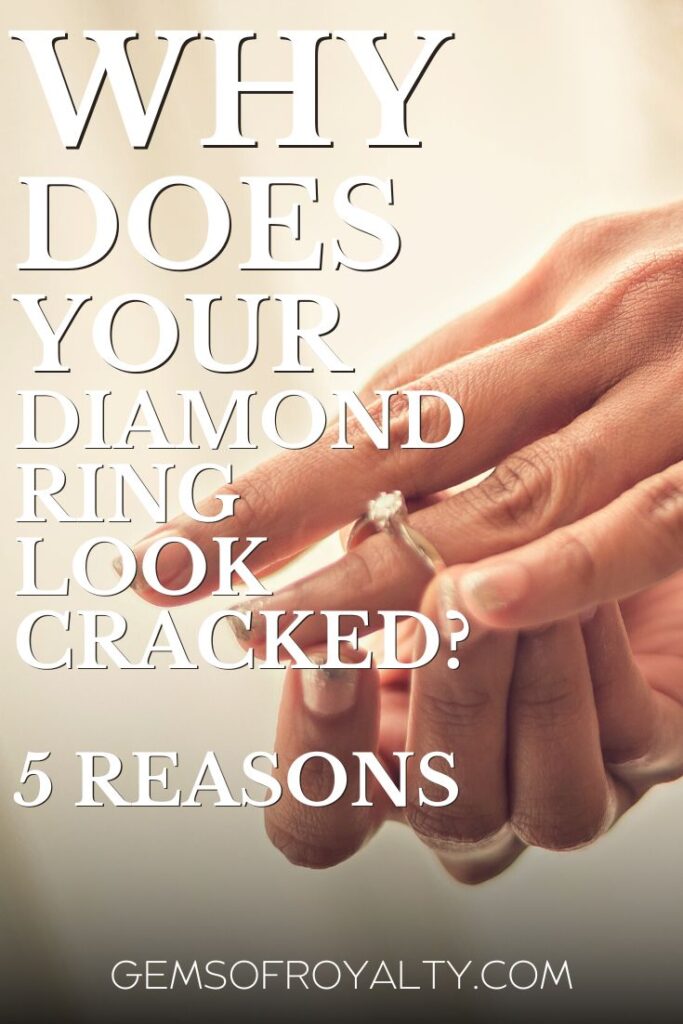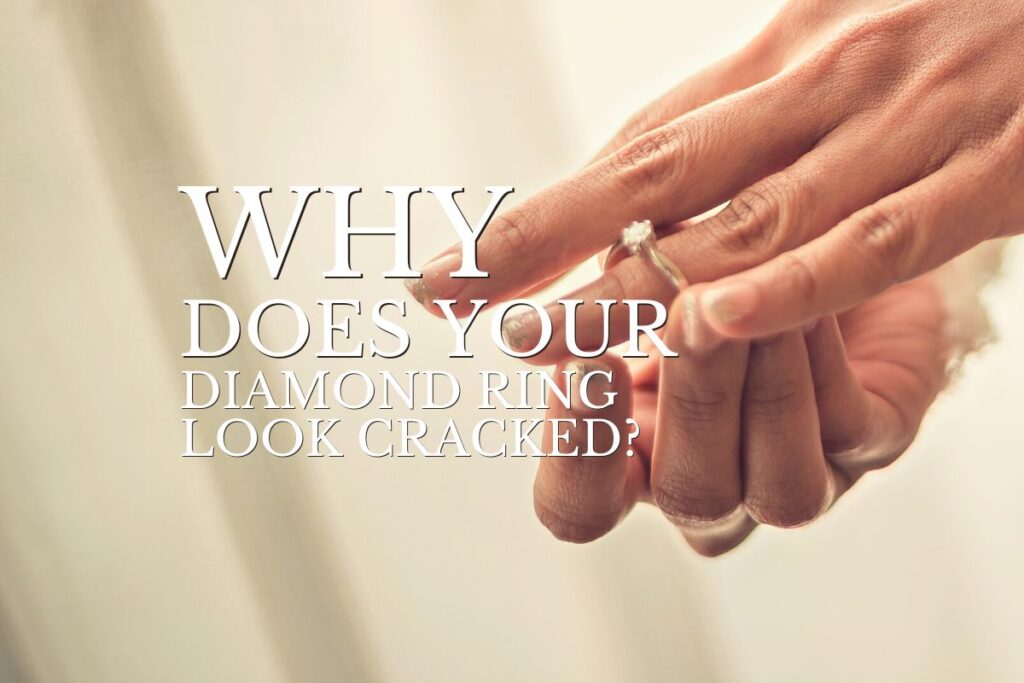A diamond ring is a valuable piece of jewelry, often with sentimental value. Due to the value of a diamond ring, it’s worrisome when a crack that wasn’t there before begins to form. So, why does your diamond ring look cracked, and how can you fix it?
Your diamond ring can look cracked for different reasons. For example, it might be dirty, which can give a cracked effect. When dirt particles get stuck on the diamond, they should be cleaned off properly. A ring may also look cracked if it has imperfections or has been damaged.
Want to learn more about why your diamond ring looks cracked? Read this article to get all the essential information and guidance.
Possible Reasons Your Diamond Ring Looks Cracked
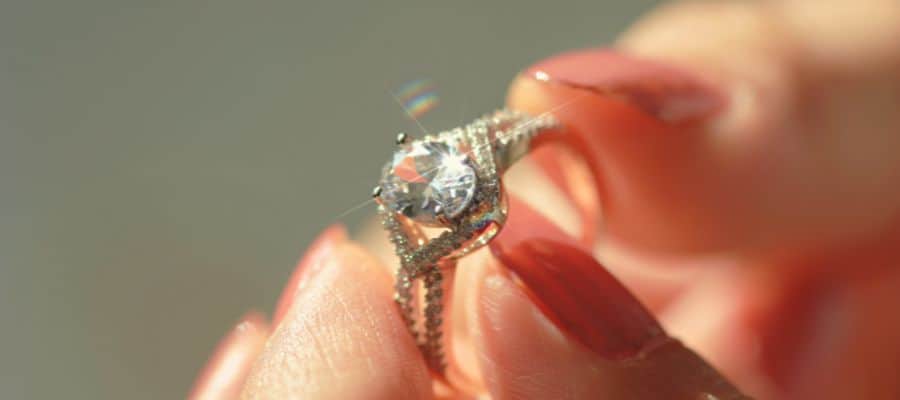
Before thinking about why your diamond ring looks cracked, there are a few things to consider:
- The age of the diamond ring. Wear and tear could be the culprit if it’s an old ring. If it’s brand new, the crack could be an imperfection.
- How quickly the crack showed up. If the crack showed up overnight, you likely dropped it against a hard surface. If it showed up more slowly, it could be a dirt buildup!
- How noticeable the crack is. If it’s very noticeable, it’s more likely to be seriously damaged. If it’s a small crack and not highly noticeable, it may not be damaged at all. Instead, it could be a characteristic of the diamond or dirt. It may also be a reflection.
Now that you’ve thought about the above let’s examine why your diamond ring looks cracked!
1. The Diamond Ring Is Dirty
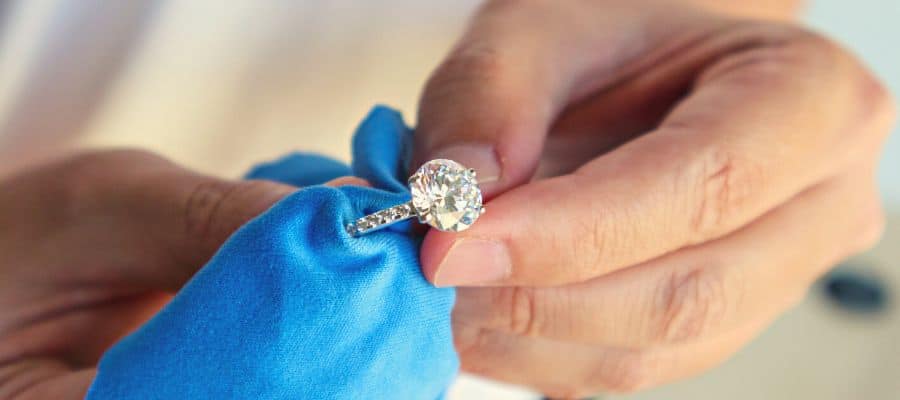
First and foremost, ensuring the “crack” you’re seeing isn’t just a buildup of dirt and debris is essential. Over time, it’s easy for a diamond ring to get a little dirty, and this dirt can easily be mistaken for damage when it gets stuck on the diamond.
As I mentioned earlier, a “crack” that shows up slowly is more likely to be dirt than an actual crack. It will also be much less noticeable than a genuine crack–real cracks on diamonds are generally extremely noticeable immediately and require intervention.
If you suspect the diamond ring is dirty and therefore has a cracked appearance, clean it carefully. Below is a brief guide on how to clean a diamond ring:
- Gather the necessary ingredients and equipment. That includes mild soap, warm to hot water, a small brush, a dry cloth, and a container.
- Place a few teaspoons of soap into a small container of hot water.
- Submerge the diamond ring into the mixture and let it soak for a few minutes.
- Remove the ring from the water and scrub it gently using a small brush.
- Rinse the ring with water and dry it with a clean cloth.
After cleaning the ring, you should notice the cracked appearance is gone. If it’s still there, the issue likely wasn’t caused by dirt, so you’ll need to consider other options.
2. It’s the Design of the Diamond

If you have recently bought or received a diamond ring and it’s always had the appearance of a crack, consider the possibility of a crevice or inclusion.
Inclusions are normal occurrences on diamond rings, with most diamonds having at least one. An inclusion is essentially an imperfection that occurs during the process of making the diamond ring. Inclusions may sometimes appear as black specks on diamonds, which can look similar to cracks.
Inclusions are usually composed of minerals that get stuck in the diamond, which makes them stand out in some cases. When you purchase a diamond ring, it’s good to get information on the recorded inclusions because it affects the general value of the ring.
Diamonds also often have naturally occurring crevices, which can sometimes look like cracks.
Consider the Clarity of the Diamond
The clarity of your diamond ring can help determine how many inclusions and other imperfections are present.
If you recently bought the ring and have the original documentation, check that to see if any information is available on the clarity. If you don’t have documentation, consider bringing the ring to a jeweler so that they can check the clarity under a microscope.
The clarity tells you how pure your diamond ring is. The clarity of diamonds is organized as follows:
- I1. I1 means there are few inclusions.
- I2. I2 means there are a fair amount of inclusions.
- I3. I3 means many obvious inclusions, which could look like a crack or multiple cracks.
If your ring has an I2 or I3 grade, the “crack” you notice is more likely to be an inclusion that can’t be fixed. However, a ring with a high level of clarity is unlikely to have visible inclusions, so the cause of the crack could be something else.
3. The Diamond Ring Is Damaged
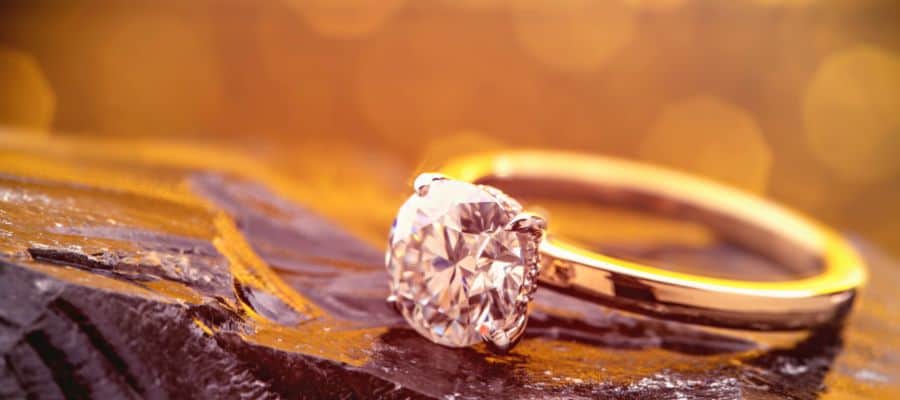
The diamond ring is likely damaged if there’s a prominent crack. Think about whether or not you recently hit the ring or dropped it on a hard surface at a fast speed. Although hard and tough, diamonds can crack and break with enough force.
You should also ask yourself if the crack has appeared out of nowhere. If it has, it’s more likely damaged after a rough fall. There’s a higher possibility that the crack indicates damage if it was not visible when you first bought the ring and has only become apparent recently.
In the case of damage, it’s best to bring the ring back to where you bought it to see if they can fix it or replace it. Some sellers may provide buyer protection and warranty, so it’s always good to check the conditions.
If the ring is old, bring it to any trustworthy jeweler so that they can look at it and give advice on what to do next.
The solution you get will depend on the general quality of the diamond and how bad the crack is. Later in the article, I’ll discuss whether or not a diamond can be repaired if it’s cracked or damaged in another way.
4. The Diamond Is Fake
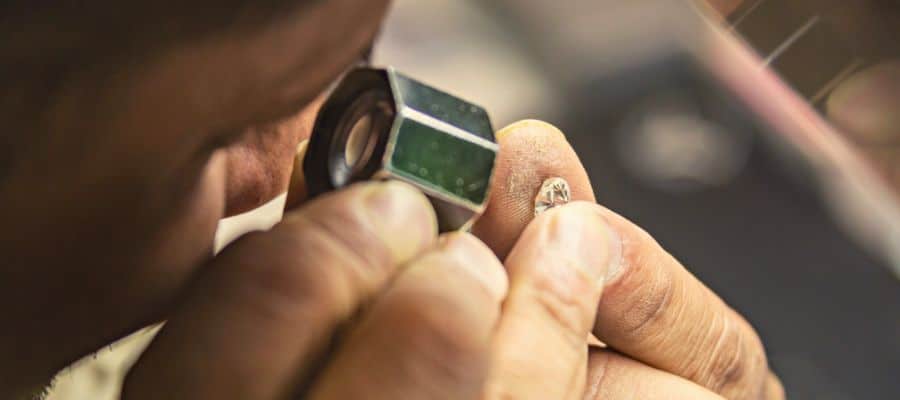
Although it rarely happens, real diamonds are unlikely to crack or become damaged in most instances. Therefore, the diamond probably isn’t authentic if you notice a crack and have already ruled out inclusions and dirt.
Of course, you can ignore this consideration if you’re confident the diamond is real (for example, if you bought it from a trustworthy seller and have no worries about its authenticity).
However, if you have any doubts, examine the ring to ensure it’s real. A fake diamond is more likely to crack and get damaged easier. Since diamond is a highly rigid and tough material, it’s unlikely to crack or break. On the other hand, a fake diamond can be made of all kinds of materials, many of which can break or crack easily.
If you noticed the crack appeared after a slight bang on the floor that wasn’t even that hard, consider getting it checked for authenticity.
The diamond is more likely to fall off the ring if it’s fake because it won’t be as secure due to the lower-quality materials.
Here are some of the main indications your diamond ring is fake:
- If it feels super lightweight. A diamond ring will generally feel somewhat heavy, so if it feels oddly light, it could be fake.
- The diamond floats in water. Of course, it’s not always possible to do a water test with a diamond ring, but you can do it if the diamond comes loose and falls off. A diamond that floats or sinks slowly is fake because real diamonds always sink quickly.
- It doesn’t appear blue under UV light. A real diamond should appear slightly blue under UV light. If your diamond ring doesn’t, it’s probably fake.
If you’re still uncertain, bring the cracked diamond ring to a trustworthy and knowledgeable jeweler who can examine it to check its authenticity.
5. A Repair Went Wrong
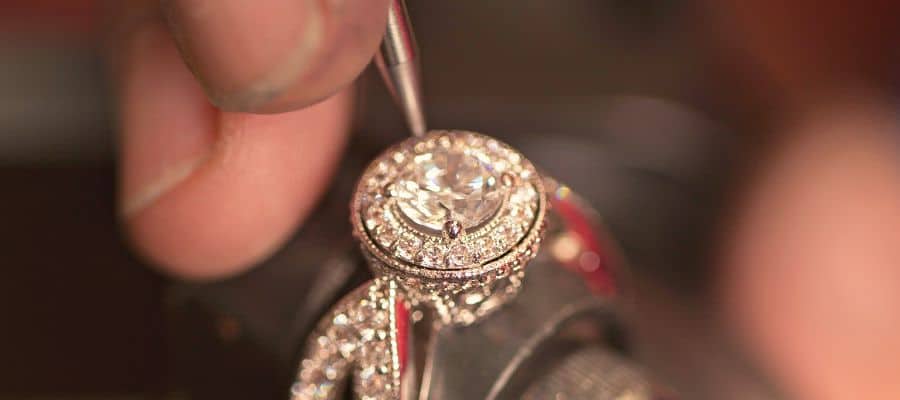
Have you recently had your ring repaired or serviced and are only now noticing a crack? If that’s the case, the repair might have gone wrong, causing further damage to the diamond.
If you have a photo of the diamond ring before the repair service, go back and check it to see the difference between then and now. The repairer may have accidentally chipped the diamond or caused debris to get stuck. In that instance, bring the ring back to the repairer to rectify the problem or get your money back.
A repair will generally only go wrong if you bring the ring to an untrustworthy place. For example, if the price of a repair seems too good to be true, it probably is! If you feel uncomfortable bringing the ring back to the original repairer, consider bringing it elsewhere to see what can be done.
Unfortunately, a ring repair that causes further damage to the diamond can’t always be fixed, especially if the diamond is small.
Can a Cracked Diamond Ring Be Repaired?

Whether or not a diamond ring can be repaired depends on the situation. For example, if it’s a rather large diamond, it can likely be shaved down or recut to remove the crack or damage (in some cases).
If the diamond is already on the smaller side, shaving it down might not be an option because there might not be enough material to salvage. The best thing to do is to bring your ring to a jeweler and get a professional opinion on your options. One of the most common diamond ring repair methods is recutting.
Recutting a Cracked Diamond Ring
Recutting the diamond involves reshaping it by cutting away certain parts. For example, removing cracks and imperfections is sometimes possible by recutting a diamond. Although recutting a diamond ring is an excellent way to restore it, there are some considerations:
- Recutting isn’t possible in small diamond rings. If the diamond on your ring is tiny, recutting is unlikely to be a viable solution to the problem because there mightn’t be enough diamond mineral left at the end!
- Recutting will alter the appearance of your diamond ring. Unfortunately, recutting will make your diamond ring smaller because the process involves cutting away certain parts. Before the repair, make sure you’re OK with the appearance change.
- Recutting is expensive. Don’t expect to pay $100 on a diamond ring recutting. Although the price will depend on the quality of the diamond and the amount of work required, it will always be pricey.
Once you’re OK with the above, getting a cracked or otherwise damaged diamond ring recut is a viable and smart option. However, if it’s a similar price to buy a new diamond ring, it might not be worth getting it recut.
Should You Replace a Cracked Diamond Ring?
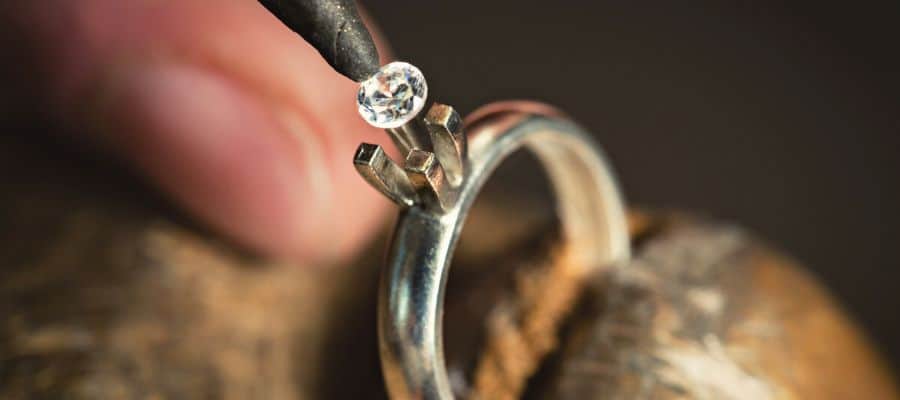
You should replace a cracked diamond ring in some cases, mainly if there is extensive damage. In other cases (where repair is possible), it might not be worth replacing.
It’s also essential to determine the cause of the crack before purchasing a replacement. For example, the crack might be a normal imperfection in the diamond (like an inclusion), meaning a replacement isn’t necessary.
Since most genuine cracks in diamond rings are severe, you might have no choice but to replace yours. Bring it to a qualified jeweler if you need clarification on whether a replacement or repair is warranted.
Are Cracked Diamonds Worth Anything?
Cracked diamonds can still be worth something, even severely damaged. In many cases, a cracked diamond can be repaired via recutting, meaning it can still remain valuable. However, a cracked diamond can lose some of its value.
Even if a diamond ring has been repaired, it can lose value. The value it loses depends on the extent of the damage. It will also depend on how much material needs to be cut off. If the diamond is half its original size after a repair, expect it to lose a decent amount of value.
A cracked diamond may only be worth a little if it’s too tiny to be recut or repaired in any way. So, as you can tell, it all depends on the diamond itself!
Final Thoughts
After reading this article, you should better understand why your diamond ring looks cracked. Remember that it might not be an actual crack–it could be an inclusion or other natural occurrence. Figure out the most likely explanation before considering a solution.
If you found this article useful, make sure you save this pin below to your Jewelry board.
